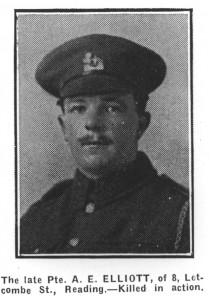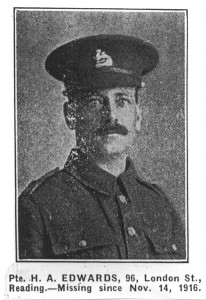Albert Edward Elliott
Private 16171
2nd Battalion Royal Berkshire Regiment
 |
Albert Edward Elliott is commemorated on a shield with the words ‘Albert Killed in France April 24th 1918’. The CWGC gives the date of death as 27th April 1918; there are no family details recorded. A second shield gives the name of Nellie, died November 12th 1920. Nellie was in fact his wife, her maiden name was Pickett. The couple married in the second quarter of 1915. The Burial Register confirmed that her name was Elliott. The Berkshire Family History Society classification is given as 29F33. The Reading Cemetery grave number is 16753.
Albert Elliott has no known grave and is commemorated on the Pozieres Memorial, panel 56 & 57.
In the days leading up to his death there had been heavy fighting in the area of Albert. This was because of the German Spring offensive and the push by them towards Amiens.
An ‘In Memoriam’ published on 26th April 1919, gives an address of 44, Brunswick Street and the name of Harry and Penn his brother and sister. The picture of Albert Elliott gives his home address as 8, Letcombe Street, Reading. This was the address of his wife. A poignant verse accompanies the ‘In Memoriam’.
Oh not lost, but gone before us
Let him never be forgot
Pointing up to that far Heaven
Where we hope to meet at last.
We know from the grave inscription that it was not long before Nellie herself died.
The 1911 census indicates that Albert Elliott was living with his sister Harriet and husband Charles and their young family at 103 Liverpool Road, Reading. Frederick, his 16 year old brother, was also living with the family. Albert was working as a labourer at Huntley and Palmers Biscuit Factory. The author believes that Albert Elliott was born about 1892 making him about 26 years at the time of his death.
